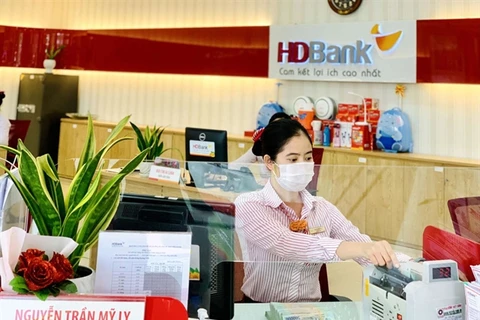Hanoi (VNA) - The banking sector needs to have countermeasures to flexibly adapt to the COVID-19 pandemic. This will help to reduce costs, promote innovation, digital transformation and cashless payment, towards assisting the retail banking sector to providing breakthrough services in the new normal.
The issue was under discussion at a forum on retail banking, which was jointly held by the Vietnam Banks Association (VNBA) and the International Data Group in Vietnam (IDG Vietnam) on March 25 in Ho Chi Minh City.
Decrease in cash withdrawal transactions
According to Dr. Nguyen Quoc Hung, General Secretary of VNBA, retail banking service has become an inevitable trend and key development strategy of banks.
Although they significantly affected the operation of banks, social restrictions to prevent the spread of the COVID-19 pandemic was also an opportunity for banks to accelerate digital transformation in order to adapt to the new normal.
Banks have outlined policies and solutions to develop a digital platform-based retail banking service. These include developing modern banking products and services, new multi-utility distribution channels including mobile banking, internet banking, QR code, and eKYC technology, thus mobilising idle capital from individual customers.
Individual consumer loan service has strongly developed with simple and convenient procedures.
Bank credit moved in the right direction in 2021, with the ratio of retail loans of medium and large banks accounting for 40% - 50%. Consumer loans of financial companies reached nearly 200 trillion VND (98.55 billion USD), nearly 6% higher than that recorded in 2020.
Over 90% of transactions in many banks are currently conducted via digital channels, central bank data shows.
In 2021, payments via mobile banking soared 76.2% in volume and 87.5% in value compared to a year earlier. The corresponding figures were 48.8% and 32.6% percent for payments via Internet banking.
Notably, payment via QRcode surged by up to 200% compared to 2020.
The ratio of cash withdrawal via ATM out of total transactions processed through NAPAS's system dropped sharply from 26% in 2020 to 12% in 2021.
Thanks to development trend of retail banking services, banks have retained a solid growth rate, created added value, and supported customers in the COVID-19 period.
The banking system has exempted and reduced over 37.5 trillion VND of loan interest, while 80% of transactions are being provided free of charge.
According to Le Anh Dung, Deputy Director in charge of the Payment Department under the State Bank of Vietnam, nearly 1 million new accounts were opened for using Mobile Money service provided by three leading telecom services providers - Viettel, VNPT and MobiFone.
Additionally, about 3.37 million bank payment accounts were set up using electronic Know-your-Client (eKYC) method, he said.
Challenges
Digital transformation in the banking system still faces some barriers, participants said, pointing out challenges facing the banking sector in developing retail banking service in rural and remote areas.
Linh Duc Hoang from the Vietnam Bank for Agriculture and Rural Development (Agribank) said due to consumption habits of people in rural and remote areas, the percentage of people using cash for payment remains high. Non-cash payment remains limited in rural Vietnam.
He attributed the situation to limited information technology infrastructure for electronic transactions, the instable telecommunications networks and slow Internet and Wi-Fi speed in rural areas, saying that these are all barriers to cashless payment.
Participants also mentioned challenges related to hi-tech crime and cyber security in promoting cashless payment, which require banks to strengthen security and safety solutions for their customers’ transactions.
The Politburo’s Resolution No 52-NQ/TW determines the financial-banking sector as one of the priority areas, a focus area for pioneering sectors in digital transformation.
The SBV issued Decision No. 810/QD-NHNN approving a plan for digital transformation of the banking sector by 2025, with a vision to 2030, focusing on developing a digital and smart banking system. /.
























